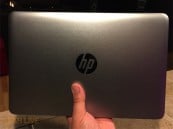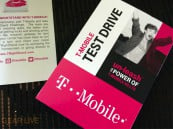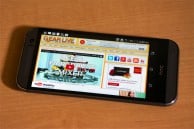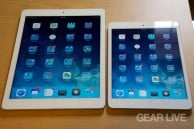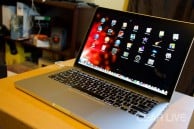Find Our Latest Video Reviews on YouTube!
If you want to stay on top of all of our video reviews of the latest tech, be sure to check out and subscribe to the Gear Live YouTube channel, hosted by Andru Edwards! It’s free!
Friday December 9, 2011 6:27 pm
LG Nitro HD review

The LG Nitro HD ($249.99 with two-year contract) is the third smartphone to tap into AT&T's emerging 4G LTE network and (after the HTC Rezound) the second phone available in the U.S. to feature a 720p display. That display looks absolutely dazzling in person and the Nitro is a performance speed demon. We're leaving our Editors' Choice with the Samsung Galaxy S II Skyrocket ($249.99) for its better signal strength and data speeds, but make no mistake: Either phone is a great choice.
Design, Screen, Call Quality, and Data Speeds
The Nitro HD looks and feels a a lot like the Skyrocket. It measures 5.27 by 2.67 by .4 inches (HWD) and weighs 4.5 ounces. It's made entirely of matte black plastic and features a textured back panel. While the look is somewhat generic, that all seems irrelevant once you feast your eyes on the Nitro's glorious, 4.5-inch 720-by-1280 AH-IPS (Advanced High-Performance In-Plane Switching) display. It's a real stunner. At 329 ppi, it has even greater pixel density than the Apple iPhone 4S ($199, 4.5 stars), with its 326 ppi Retina Display. For further comparison, a device like the Motorola Droid RAZR ($299.99, 4.5 stars), which features a 4.3-inch qHD display, has 256 ppi.
While the Skyrocket's 480-by-800 Super AMOLED Plus display still shows gorgeous color and richer blacks, the Nitro's display is the one to beat. The Nitro is brighter, and the rich pixel density is especially noticeable while browsing the Web and watching video. Thanks to the size and resolution of the screen, you can view full desktop Web pages on the screen in landscape mode and still manage to read everything. Text on the New York Times desktop site, for example, is perfectly legible, though small, on the Nitro, while you can't really make it out at all on the Skyrocket. Streaming video on Netflix looked better on the Nitro too, with a greater level and sharpness and more accurate color detail.
There are three haptic feedback-enabled capacitive keys below the display instead of the usual four. The Options and Search buttons have been combined into one; tap it for Options, or hold it down for Search. And on a display this large, typing on the on-screen keyboard isn't a problem in either portrait or landscape mode.
The Nitro HD is a quad-band EDGE (850/900/1800/1900 MHz), tri-band HSPA+ 21 (850/1900/2100 MHz), and dual-band LTE (700/1700 MHz) device. It also has 802.11b/g/n Wi-Fi. It connected to my WPA2-encrypted network without a problem.
The Nitro is a decent voice phone. Earpiece volume goes loud, but voices sound a little thin and scratchy. On the other end, calls made with the phone sound loud and clear, though noise cancellation is mediocre. Like the earpiece, the speakerphone sounds thin and scratchy, and doesn't go loud enough to use outdoors. Calls made over a Jawbone Era Bluetooth headset ($129) fared much better, and voice dialing worked well. That's an improvement over the Skyrocket, which strangely lacks voice dialing. Battery life was good at 7 hours 13 minutes of talk time.
LTE is the bigger news here. AT&T is still in the early stages of LTE deployment; it's currently available in 15 U.S. cities, and the carrier expects to reach 70 million users by the end of the year. I tested the Nitro HD in New York City, and although it hasn't officially been announced, AT&T's 4G LTE network is definitely active here. I saw data speeds ranging from 13.5 to 15Mbps down and 12 to 14Mbps up on the Nitro, which is just fantastic. When not in an LTE area, the phone will connect to AT&T's HSPA+ 21 network.
Compared to the Skyrocket in a number of head-to-head tests, the Nitro fell slightly behind. The Skyrocket often pulled in speeds about 1Mbps greater than the Nitro, both up and down. And the Skyrocket reported better signal strength as well, which may help you hold on to a connection when you're in an area with less coverage.
Apps, Multimedia, and Conclusions
LG has applied a lighter hand with UI customizations on the Nitro than Samsung did on the Skyrocket. It doesn't look like stock Android, but the OS modifications here don't seem to slow things down. There are seven customizable home screen panels, most of which come pre-populated with various apps and widgets.
The Nitro HD is currently running Android 2.3.5 (Gingerbread). LG recently confirmed that updates to Android 4.0 (Ice Cream Sandwich) will be coming to a number of newer LG smartphones, though those details were released before the Nitro HD was announced. But the LG Optimus LTE is on that list, which is basically the same phone as the Nitro HD. That makes us think the Nitro HD will receive an update to ICS at some point in the future as well.
The phone is powered by 1.5GHz Qualcomm Snapdragon S3, dual-core CPU. Benchmarks were right on par with the Samsung Skyrocket, among the best phones on the market. Although the 1.5GHz CPU doesn't show a noticeable bump in performance over the 1.2GHz dual-core Samsung Exynos in the Samsung Galaxy S II ($199.99, 4.5 stars), it's as good as you're going to get right now. The phone is definitely ready for high-end gaming, and should be compatible with most of the 250,000+ apps in the Android Market.
The Nitro is also an excellent multimedia phone. There's 1.91GB of internal storage, plus a 16 microSD card in the slot underneath the battery cover; my 32GB and 64GB SanDisk cards worked fine as well. Music tracks sounded great through both wired headphone and Altec Lansing Backbeat Bluetooth headphones ($99, 3.5 stars). The phone was able to play AAC, MP3, OGG, WAV, and WMA music test files, but not FLAC. All of our standalone video files played back without a hitch in full screen mode at resolutions up to 1080p. Like the Skyrocket, the Nitro HD requires an MHL adapter to connect to TVs, which allows you to view video and mirror the phone's display on your television. A simple HDMI out port would have been much easier.
The 8-megapixel auto-focus camera has a single LED flash. Shutter speeds are nice and fast, but photo quality is just average. Compared to the Skyrocket, photos taken with the Nitro HD look a bit washed out and details aren't as sharp. It's still fine for quick photos, but it would've been nice to see higher quality. Recorded 1080p videos played back smoothly at 30 frames per second.
The LG Nitro HD is a fast phone, and LTE capability gives it longer shelf life than the other, LTE-less devices currently available in AT&T's lineup. The HTC Vivid ($199.99) is $50 cheaper and HTC's Sense UI layer adds some useful enhancements, but it's heavier and not as fast as the Nitro. We haven't tested AT&T's version of the Apple iPhone 4S, though we expect it to be a solid choice. It features an excellent camera, the largest app catalog available and a smooth OS. It lacks any kind of 4G, though, and its screen has been eclipsed by the larger, higher-res display on the Nitro.
We're leaving our Editors' Choice with the Samsung Galaxy S II Skyrocket because of its better signal strength, data speeds, and camera. But if you find yourself being pulled in by the higher-res display, then get the Nitro. You won't go wrong with either choice.




